That's a Wrap on Our 2021 Honda CR-V Hybrid
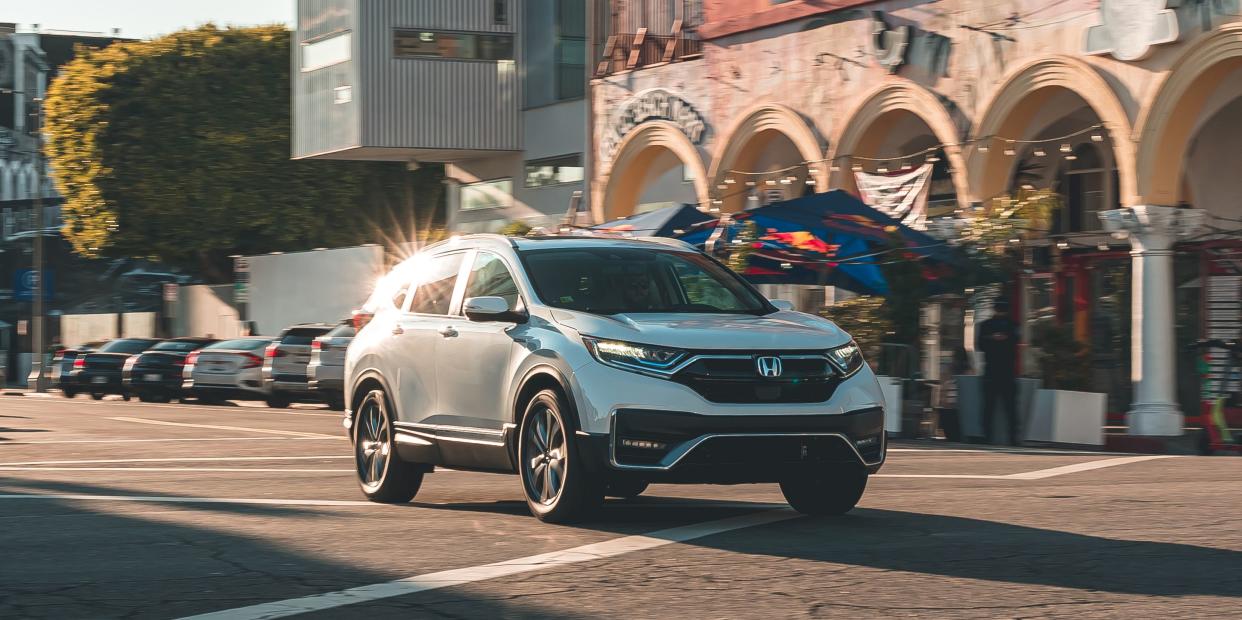
40,000-Mile Wrap-Up
Our long-term CR-V Hybrid surpassed the 40,000-mile mark during a cross-country road trip to Los Angeles. We thought that would be an appropriate place to capture its final glamour shots before we sent it back to the Honda Motor Company. As in our earlier updates on the CR-V, we still can't find much to complain about, other than its tendency to elicit a general feeling of ennui. Though this car has been described around the office as "perfectly fine," "good enough," and even "forgettable," it still proved to be a solid addition to our long-term fleet.
We've noted before that the CR-V doesn't exactly generate a weighty tome of logbook observations, but there were some shared themes. The most common complaint concerned the sound quality of the Atkinson-cycle 2.0-liter inline-four. As in the Accord Hybrid, this CR-V's engine usually functions as a generator for its two electric motors, meaning that revs don't always directly correspond to forward progress, which can be disconcerting. Also drawing ire was the CR-V's fraught relationship with Apple CarPlay, which often refused to boot up unless the car was restarted or the whole entertainment system was reset. And the Hybrid's regenerative braking, which is adjustable in four increments via steering-wheel paddles, was a source of contention. Associate news editor Caleb Miller noted, "The only thing I wish I could change is the ability to have the most aggressive regen on all the time. The regenerative-braking setting doesn't carry over to the next ignition cycle. Why, Honda?"

As with all our long-term cars, we ran initial and final instrumented tests to see how the CR-V's performance held up over 40,000 miles. The miles certainly didn't hurt the results, with the 60-mph dash improving from 7.5 seconds when the Honda was new to 7.4 seconds in our final test. The CR-V's quarter-mile time likewise improved by 0.1 second, from 16.1 seconds to 16.0. The most notable change came in the braking test, with our initial 70-to-0 mph result of 170 feet improving to 163 feet. The stopping improvement was expected, because when all-season tires wear down, the tread blocks get stiffer, often resulting in better braking numbers.
We were curious to see what extended mileage would reveal about the hybrid system's efficiency. There were occasional battles to see who could get the most miles per gallon out of their tank (42 mpg was the record, with several 37 mpg tanks). On our final road trip to California, we saw an average fuel-consumption range between 20 mpg and 32 mpg. Perhaps unsurprisingly, the CR-V returned its worst mileage in the states where we spent a lot of time at higher speeds, like Oklahoma and New Mexico. However, when tooling around L.A., the CR-V got a nice 32 mpg. The stop-and-go traffic and lower speeds are the sweet spot of efficiency for this hybrid, it seems.
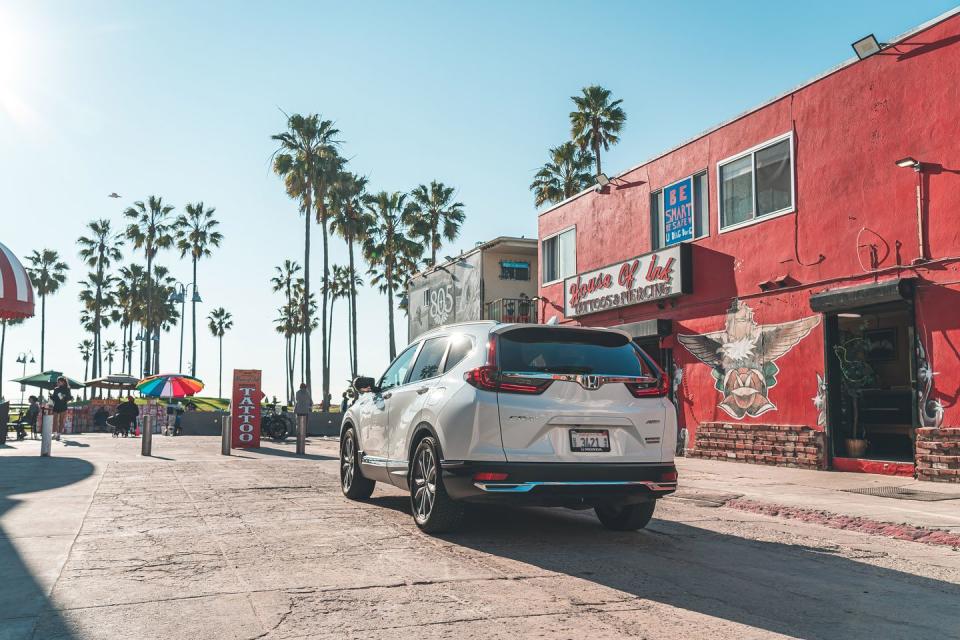
Over the course of the CR-V's stay, we averaged 30 mpg, well shy of the EPA's combined estimate of 38 mpg. Of the CR-V's worse-than-expected fuel economy, former staffer Eric Tingwall wrote, "I suspect that the aero and weight of the CR-V combined with Michigan highway speeds push Honda's strange direct-drive hybrid powertrain beyond its most efficient operating range. Like, maybe this was all designed around the Accord and Insight, or Japanese driving speeds, or both, and it just doesn't work as intended in this application at these speeds?" He would know—he bought one and has 10,000 miles on it so far.
Throughout its time with us, the CR-V visited nearly half the states in the continental U.S., proving itself a great road-trip car. We were continuously impressed by the larger-than-it-looks cargo space, array of storage compartments, and comfortable seats. And when CarPlay wasn't cooperating, we could switch over to the normal Bluetooth connection or satellite radio.

The care and maintenance of the CR-V turned out to be minimal. Over the 40,000 miles, we took it in for three service appointments. The first came around 10,000 miles, with the dealer performing an oil change without a new filter, a tire rotation, and a multipoint inspection for a total of $69. The second service, around 22,000 miles, consisted of an oil and filter change, rear-differential fluid replacement, and multipoint inspection, totaling $237. The third and final service, around 32,000 miles, included an oil and filter change, a tire rotation, an engine air-filter replacement, and a cabin air-filter replacement for $170. The grand total for all service was a mere $476. In the end, the car spent more time in the Car and Driver garage during four tire swaps over the two winters it was with us.
Overall, we were glad to have the CR-V in our long-term fleet, even if it didn't offer much driving excitement. Honda has confirmed that the 2023 CR-V will get a significant redesign—which, if it follows the path of the new Civic, could mean a more involving driving experience is on the way too. Even now, late in its product cycle, we can see why the CR-V was the fifth-bestselling car in the U.S. last year. While we might've sometimes wished we could trade the keys for those to a Civic Type R, there's a much bigger audience for something like this: a roomy, comfortable crossover that runs just as well at 40,000 miles as when it was new.
Months in Fleet: 14 months Current Mileage: 40,282 miles
Average Fuel Economy: 30 mpg
Fuel Tank Size: 14.0 gal Observed Fuel Range: 420 miles
Service: $476 Normal Wear: $0 Repair: $0
Damage and Destruction: $0
30,000-Mile Update

The more time the Honda CR-V spends time in our long-term fleet, the more it is starting to grow on us. The longer we sit in it, the more it keeps reminding us how cozy and spacious it feels and that the seats are all-day comfortable on long trips. We also can't seem to get over how big the back seat and cargo area are for a vehicle of this size—it easily held 10 days' worth of stuff on one road trip. It is easy to get into and out of and easy to see out of. With more powerful and more expensive vehicles often available, the CR-V isn't usually the first choice when selecting a car for a road trip. Afterward, however, the driver is usually happy they drove it. As senior editor Joey Capparella notes, "The car disappears around you," and it provides an all-around pleasant experience.
The CR-V has gone on several more trips since our last update. It's been to South Carolina, Ohio, Tennessee, and to Virginia International Raceway for our annual Lightning Lap. It has garnered a few more comments from staffers as they've taken these trips, but many of the comments repeat previous themes. Let's start with our complaints since that's usually what comes out first in our notes.
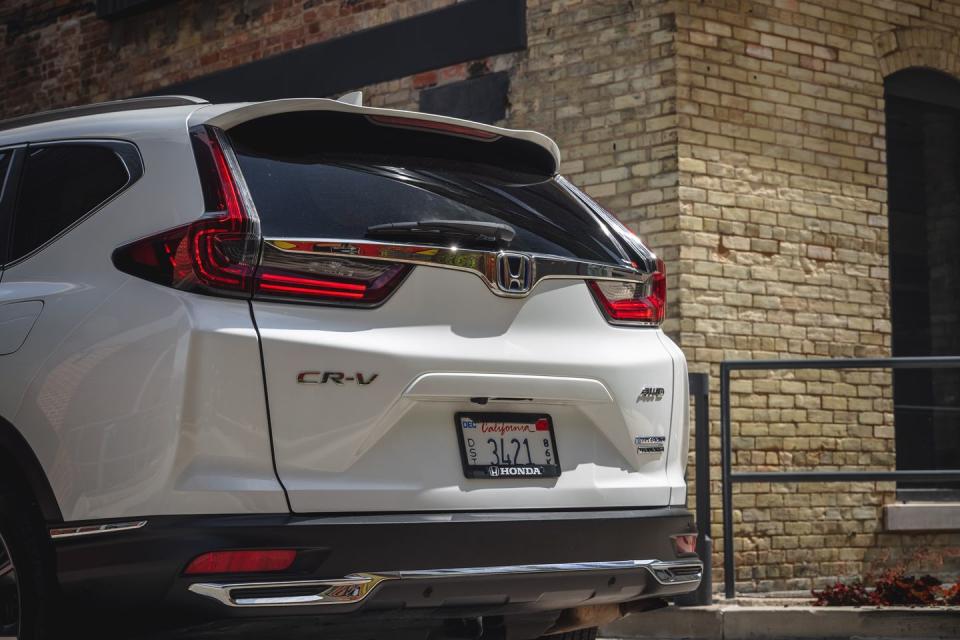
The loud hybrid engine is still a sticking point for most of our editors. We've noted in the past that at full throttle there's only 72 decibels of sound, but it seems louder. Buyer's Guide deputy editor Rich Ceppos thought it sounded like a Dyson being switched on when getting on the highway. Staff editor Eric Stafford said, "Pin the accelerator, and the engine groans like a cow giving birth." Another staffer noted that while getting up to speed on the highway, "You're required to suffer through an incredibly obnoxious engine note for what feels like an eternity."
A couple other notes from road trips mention that Apple CarPlay is tricky even after cycling the engine and restarting the paired phone. Also during all this highway driving, it was noted that the CR-V felt susceptible to crosswinds. And some drivers are bothered by the climate-control functions being divided between the dash and the touchscreen.

It's interesting how much our much gas mileage fluctuates. During the last 10,000 miles, the CR-V's average fuel economy ranged from 26 mpg to 37 mpg between fill-ups. The CR-V hasn't needed any scheduled service since our last update, but we did take the time to reinstall the Michelin X-Ice Snow SUV tires as winter is coming.
We have less than 10,000 miles left with the CR-V before it goes back to Honda. Let's see how it serves us in the next few months as the weather gets colder and the snow and ice become a part of our daily driving. Hopefully, we'll have some new things to note, although one thing is probably not going to change: The CR-V Hybrid will keep being our "Sure, I guess I can take that" road-trip car, and drivers will be glad they did.
Months in Fleet: 11 months Current Mileage: 31,960 miles
Average Fuel Economy: 31 mpg
Fuel Tank Size: 14.0 gal Observed Fuel Range 420 miles
Service: $306 Normal Wear: $0 Repair: $0
Damage and Destruction: $0
20,000-Mile Update
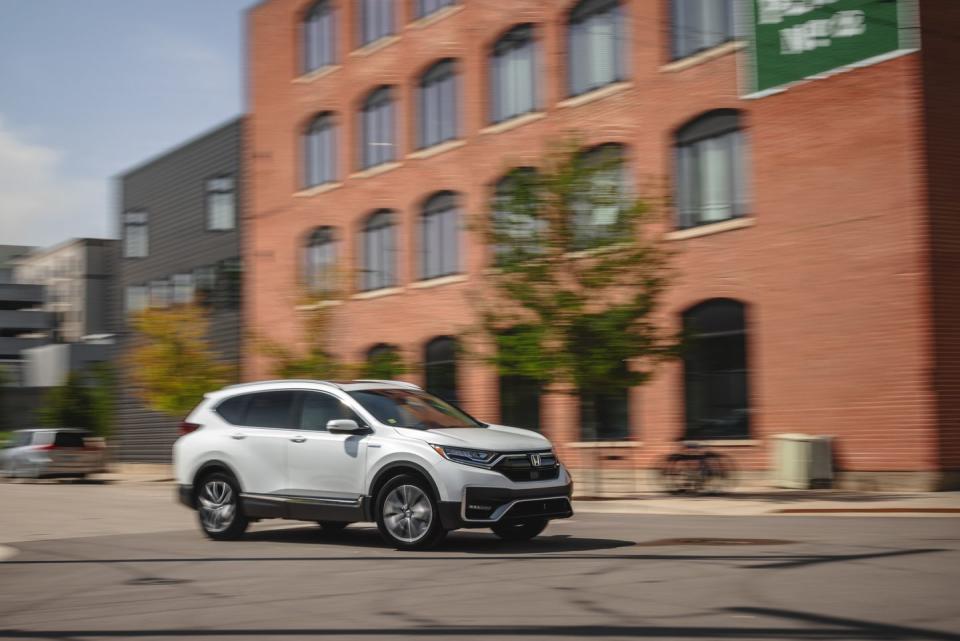
Since we last checked in, the CR-V has led an unremarkable life. We mean that somewhat literally, as only two people have taken the time to comment in its logbook: the first to complain about more hiccups with Apple CarPlay, the second to note the Hybrid's lackluster passing power on the freeway and its long-winded and "incredibly obnoxious engine note" as you hustle to merge into 70-mph traffic. That said, you have to wonder if this staffer has particularly sensitive ears, as most everyone else finds the cabin a comfortable, quiet place to spend time. Honda even padded the interior with extra sound insulation, and the audio system's active noise-canceling works to keep engine droning down to 72 decibels at full throttle. This is a huge improvement over the turbocharged 1.5-liter in the base CR-V, which helps generate 78 decibels' worth of racket when the pedal's on the floor.

Opinions also differ when it comes to the center console. Some like its flexibility and open shelving. Others would prefer a dual-level enclosed setup, thinking it would better utilize the space, but we're scraping the barrel for critiques here.
As for fuel economy, the compact crossover continues to impress around town, with some drivers seeing nearly 50 mpg. When speed ticks up, though, our average tanks. Our 75-mph highway test returned 29 mpg, six shy of the EPA's highway rating. We've mentioned this poor showing before, but it bears repeating, given that the hybrid model is supposed to be the efficient choice. We've played around a bit with the steering-wheel paddles, which adjust the level of regenerative braking you experience and should ostensibly improve fuel economy. They're a nice thought, but without looking at the owner's manual, we found it difficult to decipher how they function. The system attempts to mimic how a conventional automatic would downshift, but it doesn't make it easy for the driver to know what's going on.
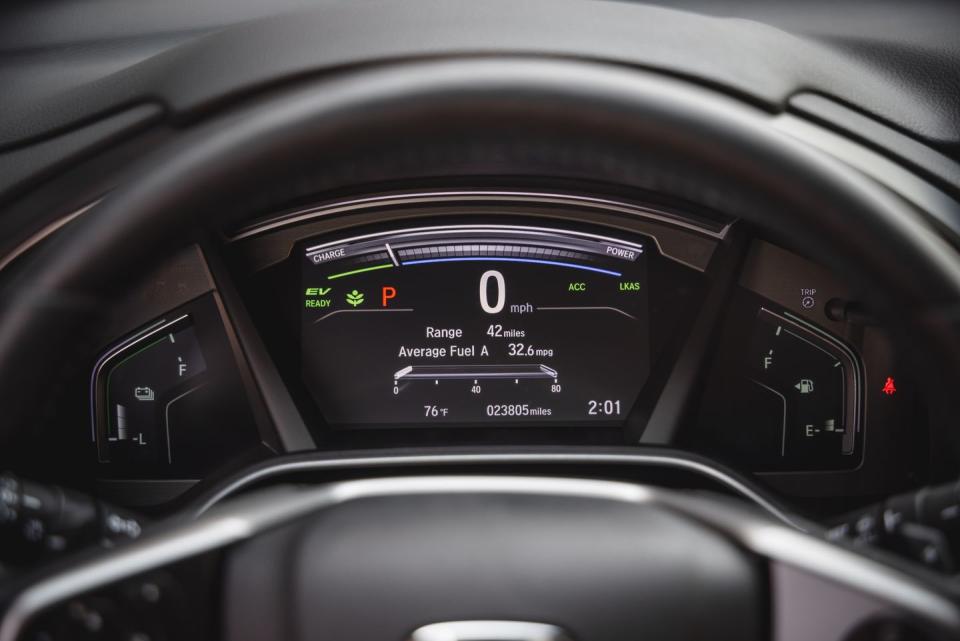
The car uses chevron graphics in the instrument cluster to show you the amount of regen at any given time, which is odd and imprecise. Numbers would be much easier to read and interpret at a glance. Then, when the system decides its work is done, you receive no feedback that it's "shifting" back to normal coasting. One commenter noted: "It makes sense that in its default mode, the regen system prevents an accidental paddle slap from locking in unnecessary regen, messing with economy and drivability, but for Honda to design it this way—with the expectation that the user will not understand it—is a bad place to start. Instead, the result is unpredictable, lacks the feedback you're accustomed to, and is unintuitive to use even if you've read the manual."
Since our last update, we took the CR-V to the dealer again for regular maintenance. Dictated by the car and not the mileage, these visits have revealed nothing untoward. After our first appointment, at 10,350 miles, the vehicle asked for another trip to the service bay just over three months and 11,000 miles later. The so-called B1 service required a bit more work and expense than the first stop. For $237, the dealer changed the oil and oil filter, rotated the tires, and inspected the battery connections, brakes, tires, and coolant levels. The tech also replaced the rear-diff fluid.

It's a good thing when service histories are unexciting, but less so on the driving front. As if in hopes of conjuring some old-school Honda feistiness from the electrified CR-V, someone slapped a Type S sticker on its butt. Which is mildly amusing, seeing how this "performance" variant—with 22 more horses than the nonhybrid CR-V—doesn't inspire spirited driving of any sort. It's transportation, not entertainment. A journey to the store likely passes in a blur, and as you walk through the automatic doors back into the parking lot to a sea of white and silver crossovers, you may wonder which one is yours. We certainly did.
We'll update you with another riveting chapter of the CR-V Hybrid story in about 10,000 miles. We'd hazard a guess they'll be just as amiable and uneventful as the first 20K.
Months in Fleet: 8 months Current Mileage: 23,444 miles
Average Fuel Economy: 30 mpg
Fuel Tank Size: 14.0 gal Observed Fuel Range: 420 miles
Service: $309 Normal Wear: $0 Repair: $0
Damage and Destruction: $0
10,000-Mile Update

During the long and gray winter months, the long-term Honda CR-V Hybrid spent most of its days traversing Michigan's flat, straight, and pockmarked roads, eliciting logbook responses of "perfectly fine," "good enough," and "I feel nothing when I drive this." To find out if a much-needed change of scenery would inspire more feelings for the CR-V, we took the Honda on a two-week road trip to Colorado's mountains.
The CR-V fit everything we needed for the 4500-mile trip—a giant duffel, a carry-on suitcase, a large shopping bag, two backpacks, bike helmets, and more—under the cargo-hold privacy screen with room to spare. We had a decent success rate with Honda's kick-under-to-open-hatch feature, but my passenger noted: "It's nice when you need it, I guess, but we didn't. Plus, you look extra silly when you try it and it doesn't work." By day four, the novelty had worn off, and we did the much easier thing of using our hands to hit the button on the liftgate or the fob.

Up front, we had plenty of places to stash our phones, masks, and snacks. While none of the actual cupholders will accommodate Nalgene's rather large water bottles, the deep bin between the seats will hold two of 'em and a Costco-size bag of Goldfish. What more could you want out of a road-trip vehicle? Comfort?
Sit in any seat long enough and your backside will begin to ache. How long a chair staves off pain is a good way to measure comfort, and the Honda's front seats kept the soreness at bay for an impressive amount of time. Discomfort began to set in late on day two, after we'd accumulated 15 hours of saddle time in a 36-hour period.

Once in the mountains, we found we had to constantly fiddle with the automatic climate-control settings, as the cabin felt much warmer than the set temperature. The HVAC didn't have to work against extreme conditions—the ambient temperature varied between the high 50s and low 70s—but Colorado's brightly shining sun likely played a role, as did the oft-elevated body temperatures of the two out-of-shape hikers in the vehicle. All the same, we wished for ventilated seats—something Honda offers on the Accord, Odyssey, Pilot, and Passport.
The Touring model's standard wireless charging pad is a good place to set your device—so long as it's encased. If you're among the 20 percent of people who don't wrap their phones in some kind of grippy material, consider relegating one of your cupholders to phone-holding duty. Otherwise, your device will likely slide off the pad even in gentle turns. Wireless charging is great for those times when everyone in your party is out of mobile range and they forget to turn on Airplane mode, thus resulting in several dead batteries. But given you need a cable to use Apple CarPlay in this Honda and that wireless charging is finicky unless the phone is perfectly aligned, the pad is best left to occasional use by passengers.
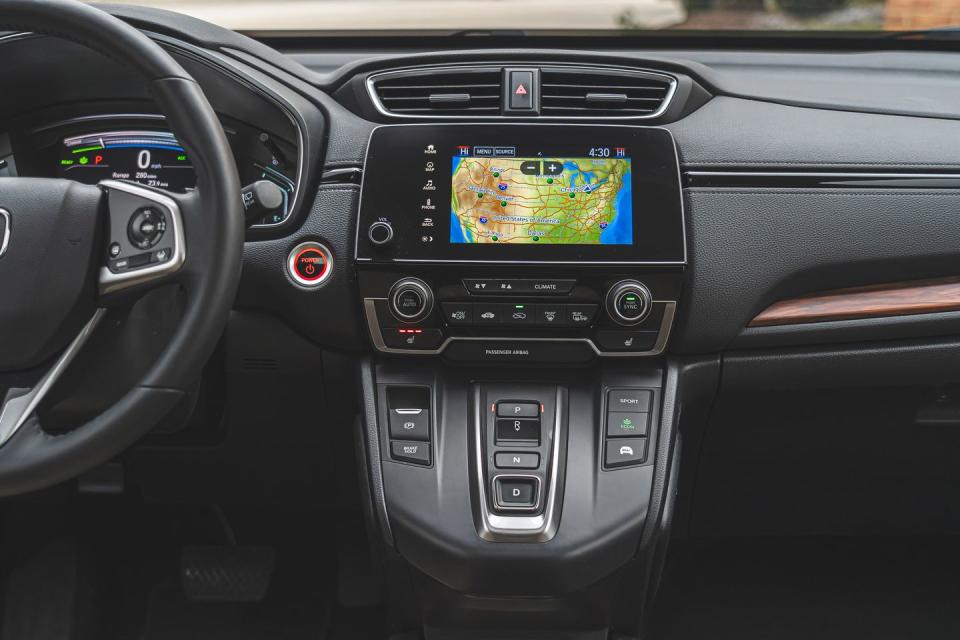
Honda's infotainment system isn't the worst out there, but it's also not the easiest to use. One logbook commenter described it in less forgiving terms, saying it's "ugly and slow and nonintuitive." For this reason—and because we wanted to binge-listen to the podcasts You're Wrong About and Conan O'Brien Needs a Friend—we bypassed Honda's native system and used Apple CarPlay for most of the trip. We made the switch to satellite radio on the last morning of our two-week adventure, when the infotainment system—which had worked flawlessly until this point—suddenly wouldn't activate CarPlay for either of our iPhones. A simple ignition cycle wasn't enough to correct the issue. Searching online forums for a solution, we discovered how to reboot the infotainment system. Simply press and hold the volume knob for 10 seconds and you'll be back to hearing Michael Hobbes explain how you're wrong about the maligned Ford Pinto.

Should you become enthralled with a podcast, the CR-V offers assistance with several aspects of driving. Enable lane keeping and the CR-V will tug at the wheel to keep you from wandering. The adaptive cruise control works to slow and accelerate based on what's in front of you. Like all of these systems, it leaves a large-enough gap (even if you select the shortest following distance) for traffic to cut in ahead of you, which then causes the Honda to brake, slowing things further.
The hybrid powertrain works seamlessly, handling the handoff between gas and electric operation without a peep, but the car's fuel economy has caused some disappointment. Print director Eric Tingwall went so far as to call it abysmal after he averaged less than 20 mpg on a tank. He wrote: "That was at a near constant 85 mph on winter tires with strong crosswinds, but still." To be fair, Honda didn't optimize the CR-V Hybrid for 85-mph cruising, but Tingwall points out that our recently departed long-term M340i averaged 30 mpg at 90 mph. Those of us who drive at lower speeds have fared better. Going west on I-80's flat stretches, we observed 35 mpg, matching the crossover's EPA highway estimate. Once we hit the mountains, the number fell well below 30 mpg.
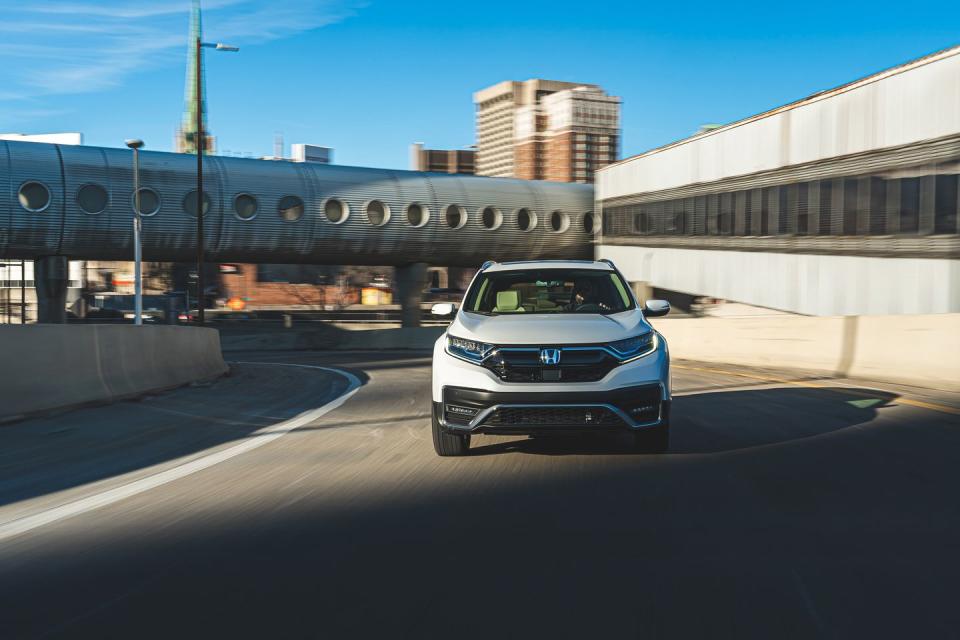
While the CR-V might not have us crafting love sonnets or jealously fighting at the sign-out board, its comfortable, smooth, and unobtrusive manners are winning our respect. And thus far, the CR-V has upheld Honda's reputation for reliable transportation, having no mechanical issues. We've taken it to the dealer for its first service visit, wherein the technician performed an oil change, tire rotation, and inspections for $69. Stay tuned for more updates as we put on the miles.
Months in Fleet: 7 months Current Mileage: 19,091 miles
Average Fuel Economy: 30 mpg
Fuel Tank Size: 14.0 gal Observed Fuel Range: 420 miles
Service: $69 Normal Wear: $0 Repair: $0
Damage and Destruction: $0
Introduction

We invited a 2021 Honda CR-V to join our long-term fleet so we could spend some quality time (and 40,000 miles) with Honda's bestseller and the fifth-bestselling vehicle in the United States. We chose the hybrid because it's new to the lineup and because we liked the 212-hp fuel-sipping powertrain in the Accord. In the CR-V, the system boosts fuel economy and performance, making it the choice for buyers who want efficiency and power. Those customers will have to shell out for it, though, given the CR-V Hybrid sits at the top of the range. In addition to shaking down the powertrain and seeing if it can deliver the promised fuel economy, we're hoping this compact crossover—the brand's first with hybrid power to make it to the U.S.—will give us a glimpse at the future of Honda, which will soon phase out gas-only powertrains in Europe.
We ordered a top-of-the-line Touring model loaded with just about everything: leather seats (heated up front), navigation, wireless phone charging, Android Auto and Apple CarPlay integration, a nine-speaker audio system, a liftgate that opens when you wave your foot under the bumper, proximity key entry, remote start, the Honda Sensing suite of driver-assistance features, and more. Our $37,920 example has but one option: white paint for $395. Perhaps it's because all of southeast Michigan is currently covered in two feet of snow or because half the vehicles in the grocery-store parking lot are also painted in America's favorite automotive hue (and shaped like tall boxes), but the CR-V blends in a little too well with its surroundings. We wouldn't call the color choice regrettable but maybe a bit forgettable.

Inside, Honda's inoffensive design, easy-to-use 7.0-inch touchscreen, and highly adjustable center console should satisfy most shoppers in this class if not the nit-pickiest staffers on our masthead. Hybrid versions differ from regular CR-Vs in a few subtle ways. A unitless battery gauge replaces the tachometer in the digital instrument cluster and tells you vaguely how much juice you're using at any given moment. Honda also opted for a push-button transmission instead of the chunky gear lever used in the core model. Staff reaction to push-button shifters is mixed, but the setup at least makes for a tidy, unobtrusive center console. In the same way a light color creates the illusion that a room is larger than it is, the Ivory surfaces in our CR-V make the cabin appear adequately spacious, which, granted, it is, offering 103 cubic feet of passenger volume. Provided that light-beige leather can withstand the dye in our Levis, the simplicity of this interior all but ensures it will age well.
A couple of hybrid caveats to note: Choosing this powertrain nullifies the nonhybrid CR-V's 1500-pound tow rating, so technical editor David Beard will have to look elsewhere when he wants to tow his snowmobile. Which is just as well, considering the cargo hold probably wouldn't fit all of his gear. The gas-electric CR-V sacrifices six cubic feet of cargo space (and its spare tire) to the battery. The upside is that, compared with a regular all-wheel-drive CR-V, you gain 9 mpg in combined driving by the EPA's yardstick. That said, if you drive like we do, you can expect much worse results: We're currently averaging a mere 27 mpg.

The Honda's road manners are in line with the amiable-but-boring norm of the segment. Its smooth ride and secure handling are immediately apparent, but there's nothing here that'll make an enthusiast grin—unless of course you're reading its VIN, which by dumb luck contains a bit of bathroom humor. Floor the accelerator and the powertrain fills the cabin with 75 decibels of sound. That's quieter than the regular CR-V's 78-decibel moan at full throttle.
Due to COVID-19 restrictions, we haven't had as many butts in these seats as we'd like, but after soft-shoeing it through the break-in period, we sent the Honda to the test track. The hybrid's drive motor can contribute 232 pound-feet of torque from the get-go, which helps this ute reach 60 mph a tenth of a second quicker than the unelectrified model, but the latter catches up by 70 mph and pips the hybrid at the quarter-mile, 15.9 seconds to 16.1. Our long-termer also lagged behind the regular CR-V in braking (170 feet versus 165) and roadholding (0.80 g versus 0.85). Given both cars wear identical Continental CrossContact LX Sport tires, we suspect the hybrid's extra 190 pounds are primarily to blame. Fortunately, in the real world, this CR-V seems more athletic than the gas-only version, and its quicker 5-to-60-mph time bears that out. As we put more miles on the odometer, we hope to see some of these numbers improve—particularly the observed fuel economy.
Months in Fleet: 2 months Current Mileage: 5131 miles
Average Fuel Economy: 27 mpg
Fuel Tank Size: 14.0 gal Observed Fuel Range: 370 miles
Service: $0 Normal Wear: $0 Repair: $0
Damage and Destruction: $0

You Might Also Like

